Building Information Modeling Impact on Cost Overruns in Australia
VerifiedAdded on 2020/10/04
|38
|12742
|452
Report
AI Summary
This report investigates the impact of Building Information Modeling (BIM) on cost overruns within infrastructure projects in Australia. It begins by highlighting the limitations of traditional project management approaches and their contribution to cost and time overruns, which pose significant risks to the construction industry. The report then explores the current state of BIM implementation, the key factors contributing to cost overruns, and the potential of BIM to improve cost performance. A comprehensive literature review examines cost overruns in Australian construction projects, factors influencing these overruns, and traditional practices used to manage them. The research methodology, employing electronic survey questionnaires, is also described. The report emphasizes the potential of BIM to facilitate better cost estimations, improve project management, and mitigate financial losses. By providing a detailed analysis of BIM's role, the report aims to contribute valuable knowledge to the construction industry, particularly focusing on cost aspects of project management and overall industry performance. The report concludes by summarizing the benefits of BIM, which include enhanced communication, improved collaboration, and better integration of design elements, ultimately leading to reduced delays and cost overruns.

BIM impact on the cost overruns in infrastructure projects in Australia
1 | P a g e
1 | P a g e
Paraphrase This Document
Need a fresh take? Get an instant paraphrase of this document with our AI Paraphraser
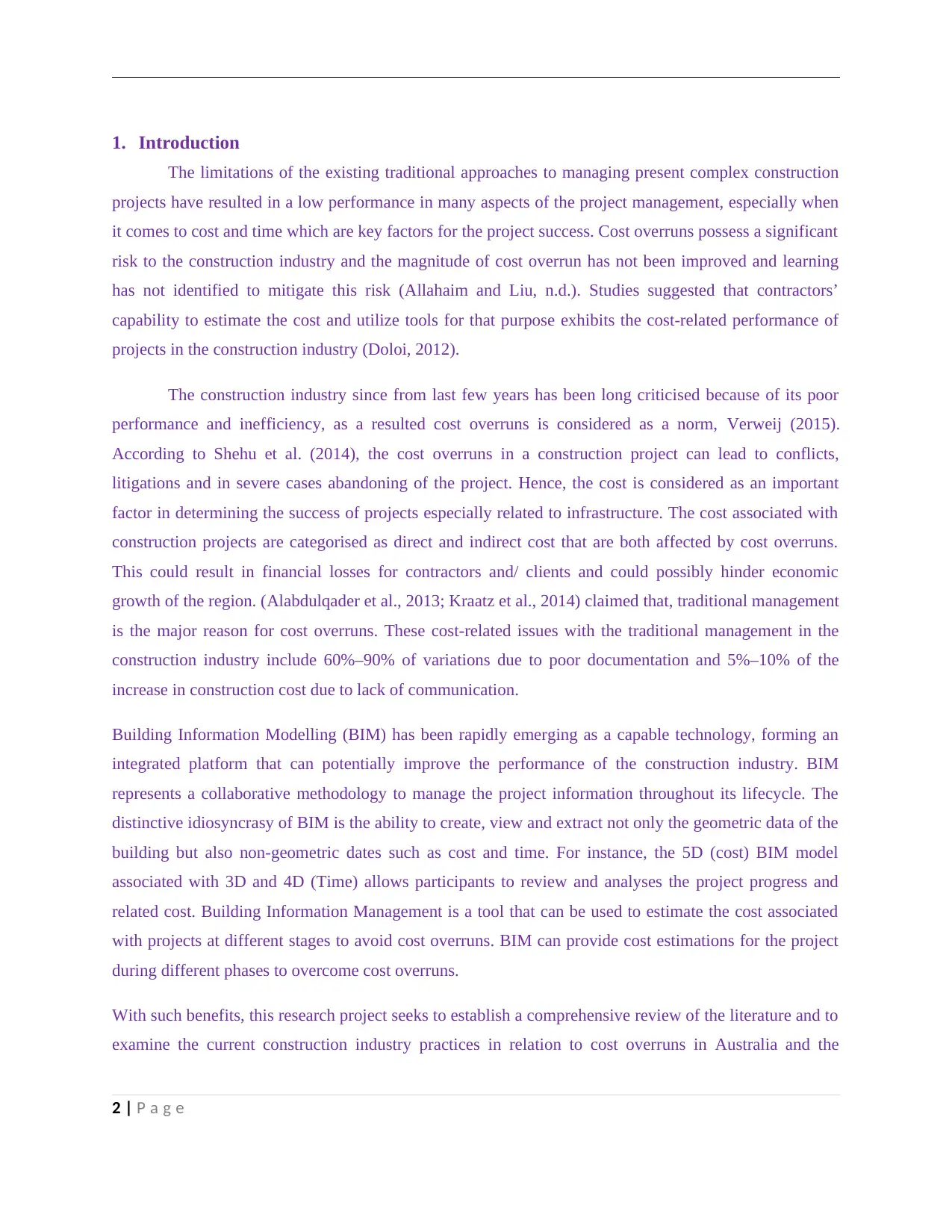
1. Introduction
The limitations of the existing traditional approaches to managing present complex construction
projects have resulted in a low performance in many aspects of the project management, especially when
it comes to cost and time which are key factors for the project success. Cost overruns possess a significant
risk to the construction industry and the magnitude of cost overrun has not been improved and learning
has not identified to mitigate this risk (Allahaim and Liu, n.d.). Studies suggested that contractors’
capability to estimate the cost and utilize tools for that purpose exhibits the cost-related performance of
projects in the construction industry (Doloi, 2012).
The construction industry since from last few years has been long criticised because of its poor
performance and inefficiency, as a resulted cost overruns is considered as a norm, Verweij (2015).
According to Shehu et al. (2014), the cost overruns in a construction project can lead to conflicts,
litigations and in severe cases abandoning of the project. Hence, the cost is considered as an important
factor in determining the success of projects especially related to infrastructure. The cost associated with
construction projects are categorised as direct and indirect cost that are both affected by cost overruns.
This could result in financial losses for contractors and/ clients and could possibly hinder economic
growth of the region. (Alabdulqader et al., 2013; Kraatz et al., 2014) claimed that, traditional management
is the major reason for cost overruns. These cost-related issues with the traditional management in the
construction industry include 60%–90% of variations due to poor documentation and 5%–10% of the
increase in construction cost due to lack of communication.
Building Information Modelling (BIM) has been rapidly emerging as a capable technology, forming an
integrated platform that can potentially improve the performance of the construction industry. BIM
represents a collaborative methodology to manage the project information throughout its lifecycle. The
distinctive idiosyncrasy of BIM is the ability to create, view and extract not only the geometric data of the
building but also non-geometric dates such as cost and time. For instance, the 5D (cost) BIM model
associated with 3D and 4D (Time) allows participants to review and analyses the project progress and
related cost. Building Information Management is a tool that can be used to estimate the cost associated
with projects at different stages to avoid cost overruns. BIM can provide cost estimations for the project
during different phases to overcome cost overruns.
With such benefits, this research project seeks to establish a comprehensive review of the literature and to
examine the current construction industry practices in relation to cost overruns in Australia and the
2 | P a g e
The limitations of the existing traditional approaches to managing present complex construction
projects have resulted in a low performance in many aspects of the project management, especially when
it comes to cost and time which are key factors for the project success. Cost overruns possess a significant
risk to the construction industry and the magnitude of cost overrun has not been improved and learning
has not identified to mitigate this risk (Allahaim and Liu, n.d.). Studies suggested that contractors’
capability to estimate the cost and utilize tools for that purpose exhibits the cost-related performance of
projects in the construction industry (Doloi, 2012).
The construction industry since from last few years has been long criticised because of its poor
performance and inefficiency, as a resulted cost overruns is considered as a norm, Verweij (2015).
According to Shehu et al. (2014), the cost overruns in a construction project can lead to conflicts,
litigations and in severe cases abandoning of the project. Hence, the cost is considered as an important
factor in determining the success of projects especially related to infrastructure. The cost associated with
construction projects are categorised as direct and indirect cost that are both affected by cost overruns.
This could result in financial losses for contractors and/ clients and could possibly hinder economic
growth of the region. (Alabdulqader et al., 2013; Kraatz et al., 2014) claimed that, traditional management
is the major reason for cost overruns. These cost-related issues with the traditional management in the
construction industry include 60%–90% of variations due to poor documentation and 5%–10% of the
increase in construction cost due to lack of communication.
Building Information Modelling (BIM) has been rapidly emerging as a capable technology, forming an
integrated platform that can potentially improve the performance of the construction industry. BIM
represents a collaborative methodology to manage the project information throughout its lifecycle. The
distinctive idiosyncrasy of BIM is the ability to create, view and extract not only the geometric data of the
building but also non-geometric dates such as cost and time. For instance, the 5D (cost) BIM model
associated with 3D and 4D (Time) allows participants to review and analyses the project progress and
related cost. Building Information Management is a tool that can be used to estimate the cost associated
with projects at different stages to avoid cost overruns. BIM can provide cost estimations for the project
during different phases to overcome cost overruns.
With such benefits, this research project seeks to establish a comprehensive review of the literature and to
examine the current construction industry practices in relation to cost overruns in Australia and the
2 | P a g e
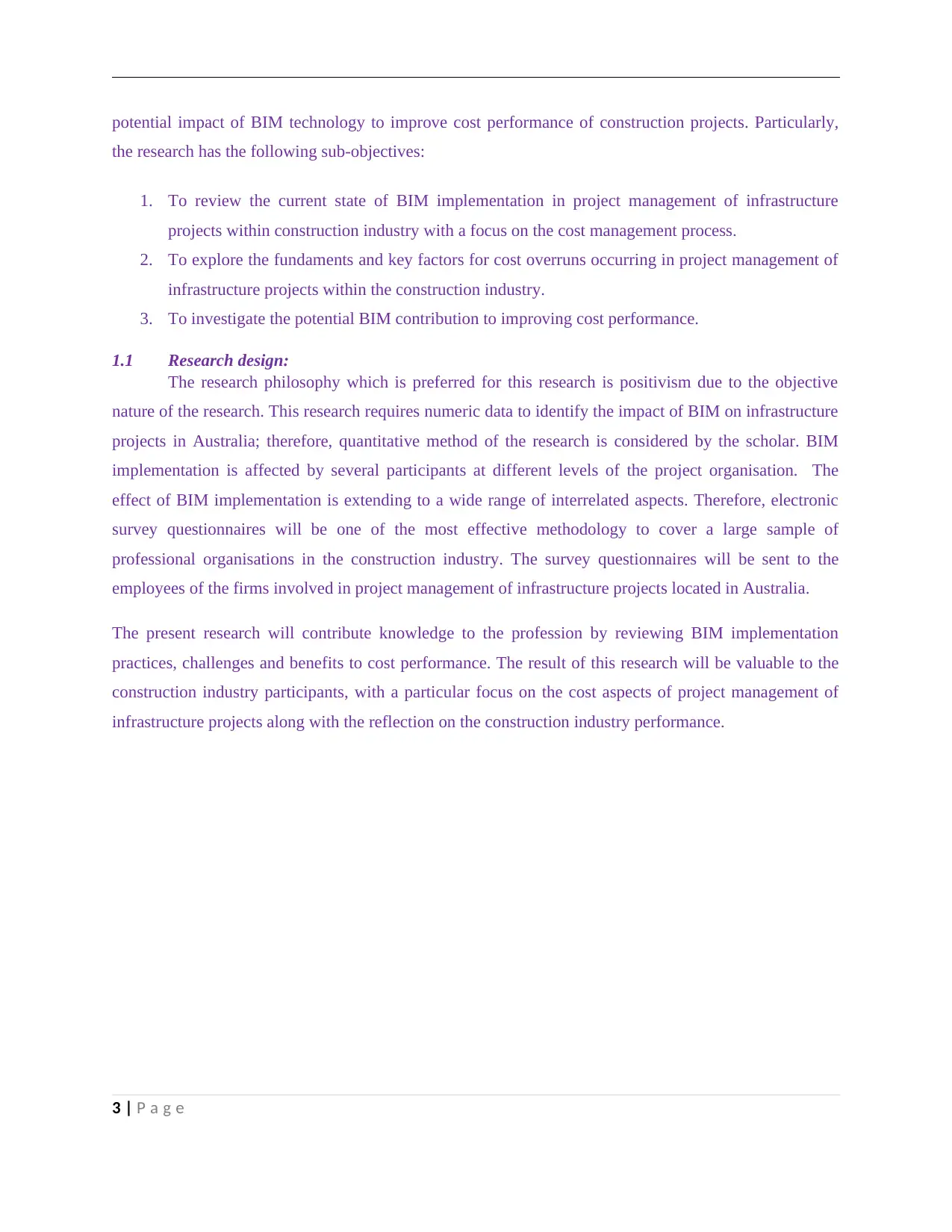
potential impact of BIM technology to improve cost performance of construction projects. Particularly,
the research has the following sub-objectives:
1. To review the current state of BIM implementation in project management of infrastructure
projects within construction industry with a focus on the cost management process.
2. To explore the fundaments and key factors for cost overruns occurring in project management of
infrastructure projects within the construction industry.
3. To investigate the potential BIM contribution to improving cost performance.
1.1 Research design:
The research philosophy which is preferred for this research is positivism due to the objective
nature of the research. This research requires numeric data to identify the impact of BIM on infrastructure
projects in Australia; therefore, quantitative method of the research is considered by the scholar. BIM
implementation is affected by several participants at different levels of the project organisation. The
effect of BIM implementation is extending to a wide range of interrelated aspects. Therefore, electronic
survey questionnaires will be one of the most effective methodology to cover a large sample of
professional organisations in the construction industry. The survey questionnaires will be sent to the
employees of the firms involved in project management of infrastructure projects located in Australia.
The present research will contribute knowledge to the profession by reviewing BIM implementation
practices, challenges and benefits to cost performance. The result of this research will be valuable to the
construction industry participants, with a particular focus on the cost aspects of project management of
infrastructure projects along with the reflection on the construction industry performance.
3 | P a g e
the research has the following sub-objectives:
1. To review the current state of BIM implementation in project management of infrastructure
projects within construction industry with a focus on the cost management process.
2. To explore the fundaments and key factors for cost overruns occurring in project management of
infrastructure projects within the construction industry.
3. To investigate the potential BIM contribution to improving cost performance.
1.1 Research design:
The research philosophy which is preferred for this research is positivism due to the objective
nature of the research. This research requires numeric data to identify the impact of BIM on infrastructure
projects in Australia; therefore, quantitative method of the research is considered by the scholar. BIM
implementation is affected by several participants at different levels of the project organisation. The
effect of BIM implementation is extending to a wide range of interrelated aspects. Therefore, electronic
survey questionnaires will be one of the most effective methodology to cover a large sample of
professional organisations in the construction industry. The survey questionnaires will be sent to the
employees of the firms involved in project management of infrastructure projects located in Australia.
The present research will contribute knowledge to the profession by reviewing BIM implementation
practices, challenges and benefits to cost performance. The result of this research will be valuable to the
construction industry participants, with a particular focus on the cost aspects of project management of
infrastructure projects along with the reflection on the construction industry performance.
3 | P a g e
⊘ This is a preview!⊘
Do you want full access?
Subscribe today to unlock all pages.

Trusted by 1+ million students worldwide
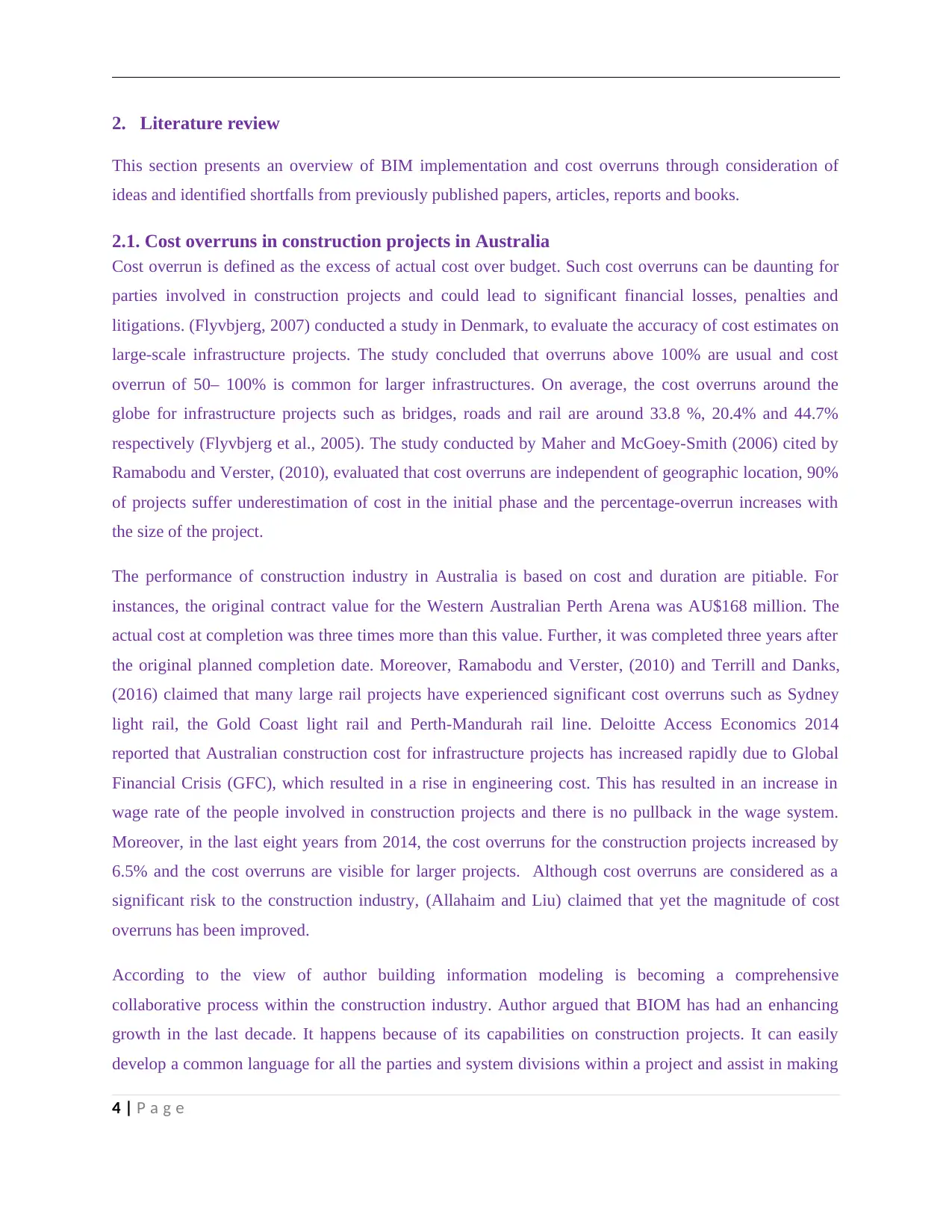
2. Literature review
This section presents an overview of BIM implementation and cost overruns through consideration of
ideas and identified shortfalls from previously published papers, articles, reports and books.
2.1. Cost overruns in construction projects in Australia
Cost overrun is defined as the excess of actual cost over budget. Such cost overruns can be daunting for
parties involved in construction projects and could lead to significant financial losses, penalties and
litigations. (Flyvbjerg, 2007) conducted a study in Denmark, to evaluate the accuracy of cost estimates on
large-scale infrastructure projects. The study concluded that overruns above 100% are usual and cost
overrun of 50– 100% is common for larger infrastructures. On average, the cost overruns around the
globe for infrastructure projects such as bridges, roads and rail are around 33.8 %, 20.4% and 44.7%
respectively (Flyvbjerg et al., 2005). The study conducted by Maher and McGoey-Smith (2006) cited by
Ramabodu and Verster, (2010), evaluated that cost overruns are independent of geographic location, 90%
of projects suffer underestimation of cost in the initial phase and the percentage-overrun increases with
the size of the project.
The performance of construction industry in Australia is based on cost and duration are pitiable. For
instances, the original contract value for the Western Australian Perth Arena was AU$168 million. The
actual cost at completion was three times more than this value. Further, it was completed three years after
the original planned completion date. Moreover, Ramabodu and Verster, (2010) and Terrill and Danks,
(2016) claimed that many large rail projects have experienced significant cost overruns such as Sydney
light rail, the Gold Coast light rail and Perth-Mandurah rail line. Deloitte Access Economics 2014
reported that Australian construction cost for infrastructure projects has increased rapidly due to Global
Financial Crisis (GFC), which resulted in a rise in engineering cost. This has resulted in an increase in
wage rate of the people involved in construction projects and there is no pullback in the wage system.
Moreover, in the last eight years from 2014, the cost overruns for the construction projects increased by
6.5% and the cost overruns are visible for larger projects. Although cost overruns are considered as a
significant risk to the construction industry, (Allahaim and Liu) claimed that yet the magnitude of cost
overruns has been improved.
According to the view of author building information modeling is becoming a comprehensive
collaborative process within the construction industry. Author argued that BIOM has had an enhancing
growth in the last decade. It happens because of its capabilities on construction projects. It can easily
develop a common language for all the parties and system divisions within a project and assist in making
4 | P a g e
This section presents an overview of BIM implementation and cost overruns through consideration of
ideas and identified shortfalls from previously published papers, articles, reports and books.
2.1. Cost overruns in construction projects in Australia
Cost overrun is defined as the excess of actual cost over budget. Such cost overruns can be daunting for
parties involved in construction projects and could lead to significant financial losses, penalties and
litigations. (Flyvbjerg, 2007) conducted a study in Denmark, to evaluate the accuracy of cost estimates on
large-scale infrastructure projects. The study concluded that overruns above 100% are usual and cost
overrun of 50– 100% is common for larger infrastructures. On average, the cost overruns around the
globe for infrastructure projects such as bridges, roads and rail are around 33.8 %, 20.4% and 44.7%
respectively (Flyvbjerg et al., 2005). The study conducted by Maher and McGoey-Smith (2006) cited by
Ramabodu and Verster, (2010), evaluated that cost overruns are independent of geographic location, 90%
of projects suffer underestimation of cost in the initial phase and the percentage-overrun increases with
the size of the project.
The performance of construction industry in Australia is based on cost and duration are pitiable. For
instances, the original contract value for the Western Australian Perth Arena was AU$168 million. The
actual cost at completion was three times more than this value. Further, it was completed three years after
the original planned completion date. Moreover, Ramabodu and Verster, (2010) and Terrill and Danks,
(2016) claimed that many large rail projects have experienced significant cost overruns such as Sydney
light rail, the Gold Coast light rail and Perth-Mandurah rail line. Deloitte Access Economics 2014
reported that Australian construction cost for infrastructure projects has increased rapidly due to Global
Financial Crisis (GFC), which resulted in a rise in engineering cost. This has resulted in an increase in
wage rate of the people involved in construction projects and there is no pullback in the wage system.
Moreover, in the last eight years from 2014, the cost overruns for the construction projects increased by
6.5% and the cost overruns are visible for larger projects. Although cost overruns are considered as a
significant risk to the construction industry, (Allahaim and Liu) claimed that yet the magnitude of cost
overruns has been improved.
According to the view of author building information modeling is becoming a comprehensive
collaborative process within the construction industry. Author argued that BIOM has had an enhancing
growth in the last decade. It happens because of its capabilities on construction projects. It can easily
develop a common language for all the parties and system divisions within a project and assist in making
4 | P a g e
Paraphrase This Document
Need a fresh take? Get an instant paraphrase of this document with our AI Paraphraser
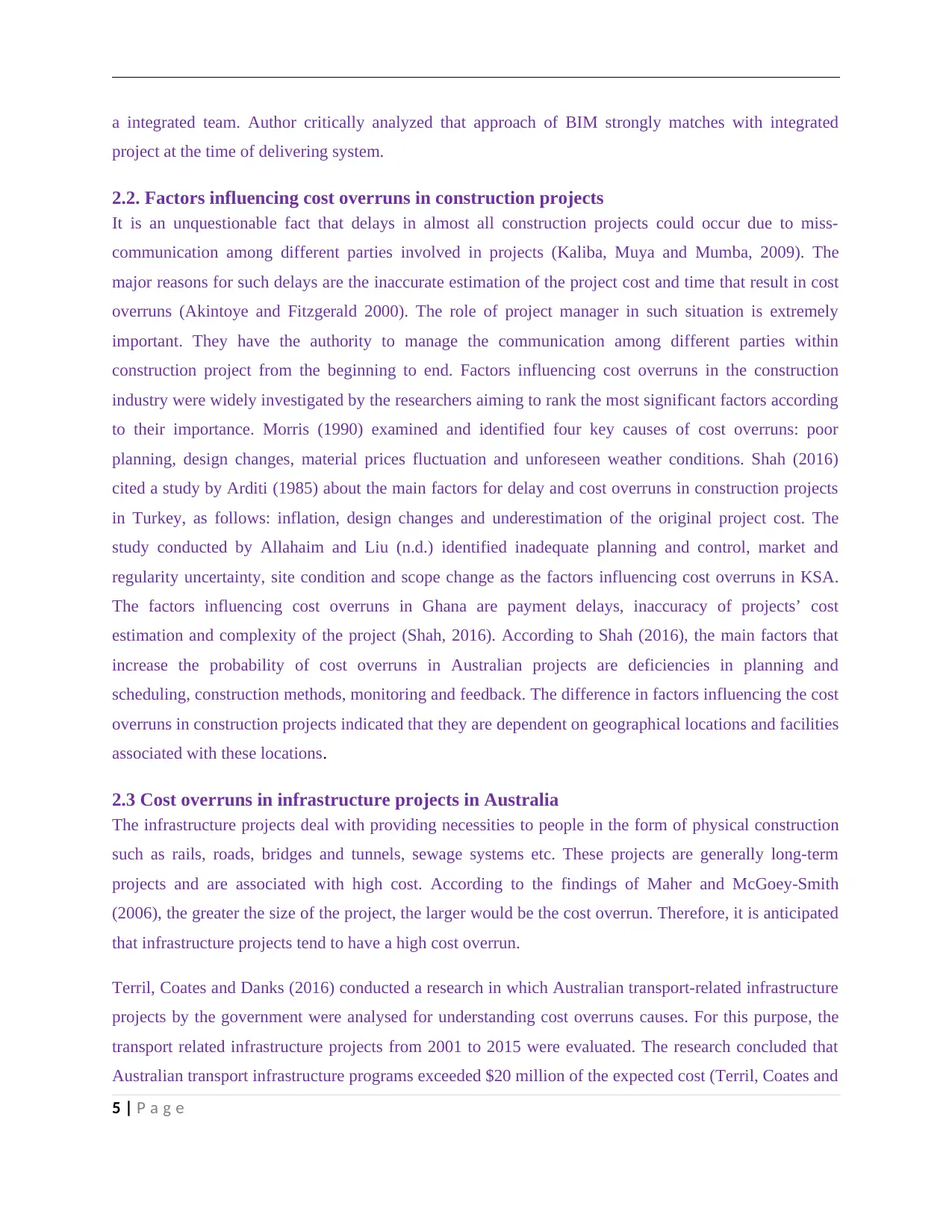
a integrated team. Author critically analyzed that approach of BIM strongly matches with integrated
project at the time of delivering system.
2.2. Factors influencing cost overruns in construction projects
It is an unquestionable fact that delays in almost all construction projects could occur due to miss-
communication among different parties involved in projects (Kaliba, Muya and Mumba, 2009). The
major reasons for such delays are the inaccurate estimation of the project cost and time that result in cost
overruns (Akintoye and Fitzgerald 2000). The role of project manager in such situation is extremely
important. They have the authority to manage the communication among different parties within
construction project from the beginning to end. Factors influencing cost overruns in the construction
industry were widely investigated by the researchers aiming to rank the most significant factors according
to their importance. Morris (1990) examined and identified four key causes of cost overruns: poor
planning, design changes, material prices fluctuation and unforeseen weather conditions. Shah (2016)
cited a study by Arditi (1985) about the main factors for delay and cost overruns in construction projects
in Turkey, as follows: inflation, design changes and underestimation of the original project cost. The
study conducted by Allahaim and Liu (n.d.) identified inadequate planning and control, market and
regularity uncertainty, site condition and scope change as the factors influencing cost overruns in KSA.
The factors influencing cost overruns in Ghana are payment delays, inaccuracy of projects’ cost
estimation and complexity of the project (Shah, 2016). According to Shah (2016), the main factors that
increase the probability of cost overruns in Australian projects are deficiencies in planning and
scheduling, construction methods, monitoring and feedback. The difference in factors influencing the cost
overruns in construction projects indicated that they are dependent on geographical locations and facilities
associated with these locations.
2.3 Cost overruns in infrastructure projects in Australia
The infrastructure projects deal with providing necessities to people in the form of physical construction
such as rails, roads, bridges and tunnels, sewage systems etc. These projects are generally long-term
projects and are associated with high cost. According to the findings of Maher and McGoey-Smith
(2006), the greater the size of the project, the larger would be the cost overrun. Therefore, it is anticipated
that infrastructure projects tend to have a high cost overrun.
Terril, Coates and Danks (2016) conducted a research in which Australian transport-related infrastructure
projects by the government were analysed for understanding cost overruns causes. For this purpose, the
transport related infrastructure projects from 2001 to 2015 were evaluated. The research concluded that
Australian transport infrastructure programs exceeded $20 million of the expected cost (Terril, Coates and
5 | P a g e
project at the time of delivering system.
2.2. Factors influencing cost overruns in construction projects
It is an unquestionable fact that delays in almost all construction projects could occur due to miss-
communication among different parties involved in projects (Kaliba, Muya and Mumba, 2009). The
major reasons for such delays are the inaccurate estimation of the project cost and time that result in cost
overruns (Akintoye and Fitzgerald 2000). The role of project manager in such situation is extremely
important. They have the authority to manage the communication among different parties within
construction project from the beginning to end. Factors influencing cost overruns in the construction
industry were widely investigated by the researchers aiming to rank the most significant factors according
to their importance. Morris (1990) examined and identified four key causes of cost overruns: poor
planning, design changes, material prices fluctuation and unforeseen weather conditions. Shah (2016)
cited a study by Arditi (1985) about the main factors for delay and cost overruns in construction projects
in Turkey, as follows: inflation, design changes and underestimation of the original project cost. The
study conducted by Allahaim and Liu (n.d.) identified inadequate planning and control, market and
regularity uncertainty, site condition and scope change as the factors influencing cost overruns in KSA.
The factors influencing cost overruns in Ghana are payment delays, inaccuracy of projects’ cost
estimation and complexity of the project (Shah, 2016). According to Shah (2016), the main factors that
increase the probability of cost overruns in Australian projects are deficiencies in planning and
scheduling, construction methods, monitoring and feedback. The difference in factors influencing the cost
overruns in construction projects indicated that they are dependent on geographical locations and facilities
associated with these locations.
2.3 Cost overruns in infrastructure projects in Australia
The infrastructure projects deal with providing necessities to people in the form of physical construction
such as rails, roads, bridges and tunnels, sewage systems etc. These projects are generally long-term
projects and are associated with high cost. According to the findings of Maher and McGoey-Smith
(2006), the greater the size of the project, the larger would be the cost overrun. Therefore, it is anticipated
that infrastructure projects tend to have a high cost overrun.
Terril, Coates and Danks (2016) conducted a research in which Australian transport-related infrastructure
projects by the government were analysed for understanding cost overruns causes. For this purpose, the
transport related infrastructure projects from 2001 to 2015 were evaluated. The research concluded that
Australian transport infrastructure programs exceeded $20 million of the expected cost (Terril, Coates and
5 | P a g e
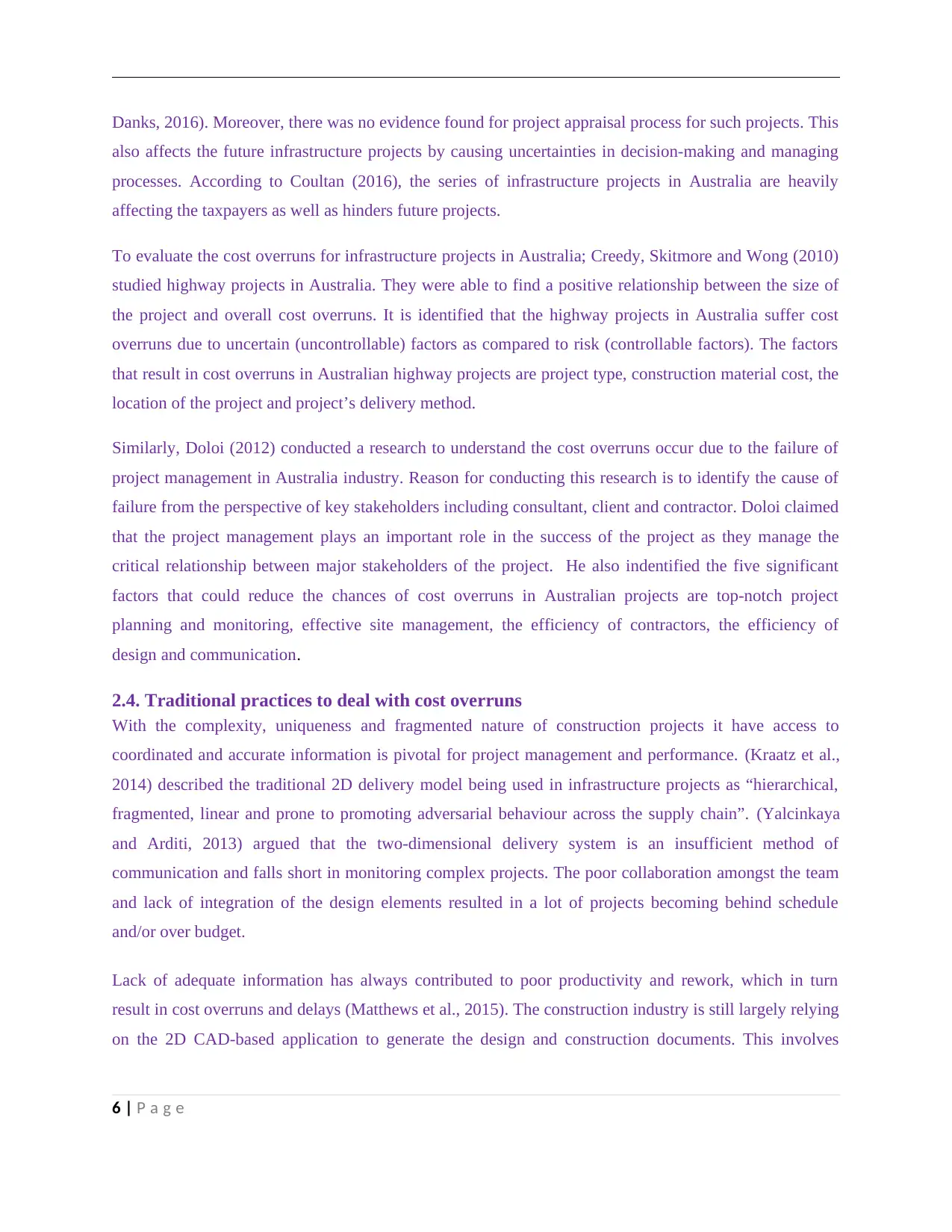
Danks, 2016). Moreover, there was no evidence found for project appraisal process for such projects. This
also affects the future infrastructure projects by causing uncertainties in decision-making and managing
processes. According to Coultan (2016), the series of infrastructure projects in Australia are heavily
affecting the taxpayers as well as hinders future projects.
To evaluate the cost overruns for infrastructure projects in Australia; Creedy, Skitmore and Wong (2010)
studied highway projects in Australia. They were able to find a positive relationship between the size of
the project and overall cost overruns. It is identified that the highway projects in Australia suffer cost
overruns due to uncertain (uncontrollable) factors as compared to risk (controllable factors). The factors
that result in cost overruns in Australian highway projects are project type, construction material cost, the
location of the project and project’s delivery method.
Similarly, Doloi (2012) conducted a research to understand the cost overruns occur due to the failure of
project management in Australia industry. Reason for conducting this research is to identify the cause of
failure from the perspective of key stakeholders including consultant, client and contractor. Doloi claimed
that the project management plays an important role in the success of the project as they manage the
critical relationship between major stakeholders of the project. He also indentified the five significant
factors that could reduce the chances of cost overruns in Australian projects are top-notch project
planning and monitoring, effective site management, the efficiency of contractors, the efficiency of
design and communication.
2.4. Traditional practices to deal with cost overruns
With the complexity, uniqueness and fragmented nature of construction projects it have access to
coordinated and accurate information is pivotal for project management and performance. (Kraatz et al.,
2014) described the traditional 2D delivery model being used in infrastructure projects as “hierarchical,
fragmented, linear and prone to promoting adversarial behaviour across the supply chain”. (Yalcinkaya
and Arditi, 2013) argued that the two-dimensional delivery system is an insufficient method of
communication and falls short in monitoring complex projects. The poor collaboration amongst the team
and lack of integration of the design elements resulted in a lot of projects becoming behind schedule
and/or over budget.
Lack of adequate information has always contributed to poor productivity and rework, which in turn
result in cost overruns and delays (Matthews et al., 2015). The construction industry is still largely relying
on the 2D CAD-based application to generate the design and construction documents. This involves
6 | P a g e
also affects the future infrastructure projects by causing uncertainties in decision-making and managing
processes. According to Coultan (2016), the series of infrastructure projects in Australia are heavily
affecting the taxpayers as well as hinders future projects.
To evaluate the cost overruns for infrastructure projects in Australia; Creedy, Skitmore and Wong (2010)
studied highway projects in Australia. They were able to find a positive relationship between the size of
the project and overall cost overruns. It is identified that the highway projects in Australia suffer cost
overruns due to uncertain (uncontrollable) factors as compared to risk (controllable factors). The factors
that result in cost overruns in Australian highway projects are project type, construction material cost, the
location of the project and project’s delivery method.
Similarly, Doloi (2012) conducted a research to understand the cost overruns occur due to the failure of
project management in Australia industry. Reason for conducting this research is to identify the cause of
failure from the perspective of key stakeholders including consultant, client and contractor. Doloi claimed
that the project management plays an important role in the success of the project as they manage the
critical relationship between major stakeholders of the project. He also indentified the five significant
factors that could reduce the chances of cost overruns in Australian projects are top-notch project
planning and monitoring, effective site management, the efficiency of contractors, the efficiency of
design and communication.
2.4. Traditional practices to deal with cost overruns
With the complexity, uniqueness and fragmented nature of construction projects it have access to
coordinated and accurate information is pivotal for project management and performance. (Kraatz et al.,
2014) described the traditional 2D delivery model being used in infrastructure projects as “hierarchical,
fragmented, linear and prone to promoting adversarial behaviour across the supply chain”. (Yalcinkaya
and Arditi, 2013) argued that the two-dimensional delivery system is an insufficient method of
communication and falls short in monitoring complex projects. The poor collaboration amongst the team
and lack of integration of the design elements resulted in a lot of projects becoming behind schedule
and/or over budget.
Lack of adequate information has always contributed to poor productivity and rework, which in turn
result in cost overruns and delays (Matthews et al., 2015). The construction industry is still largely relying
on the 2D CAD-based application to generate the design and construction documents. This involves
6 | P a g e
⊘ This is a preview!⊘
Do you want full access?
Subscribe today to unlock all pages.

Trusted by 1+ million students worldwide
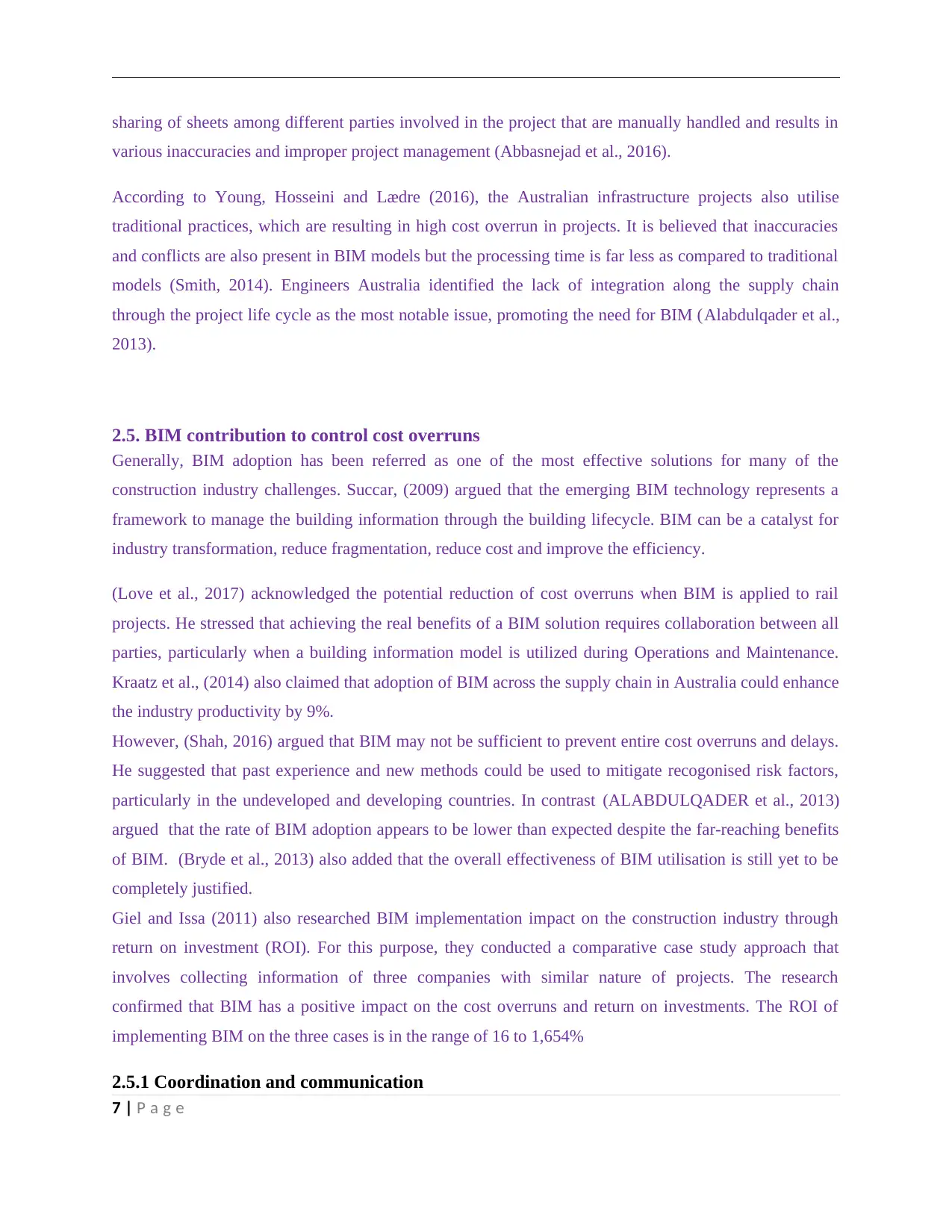
sharing of sheets among different parties involved in the project that are manually handled and results in
various inaccuracies and improper project management (Abbasnejad et al., 2016).
According to Young, Hosseini and Lædre (2016), the Australian infrastructure projects also utilise
traditional practices, which are resulting in high cost overrun in projects. It is believed that inaccuracies
and conflicts are also present in BIM models but the processing time is far less as compared to traditional
models (Smith, 2014). Engineers Australia identified the lack of integration along the supply chain
through the project life cycle as the most notable issue, promoting the need for BIM (Alabdulqader et al.,
2013).
2.5. BIM contribution to control cost overruns
Generally, BIM adoption has been referred as one of the most effective solutions for many of the
construction industry challenges. Succar, (2009) argued that the emerging BIM technology represents a
framework to manage the building information through the building lifecycle. BIM can be a catalyst for
industry transformation, reduce fragmentation, reduce cost and improve the efficiency.
(Love et al., 2017) acknowledged the potential reduction of cost overruns when BIM is applied to rail
projects. He stressed that achieving the real benefits of a BIM solution requires collaboration between all
parties, particularly when a building information model is utilized during Operations and Maintenance.
Kraatz et al., (2014) also claimed that adoption of BIM across the supply chain in Australia could enhance
the industry productivity by 9%.
However, (Shah, 2016) argued that BIM may not be sufficient to prevent entire cost overruns and delays.
He suggested that past experience and new methods could be used to mitigate recogonised risk factors,
particularly in the undeveloped and developing countries. In contrast (ALABDULQADER et al., 2013)
argued that the rate of BIM adoption appears to be lower than expected despite the far-reaching benefits
of BIM. (Bryde et al., 2013) also added that the overall effectiveness of BIM utilisation is still yet to be
completely justified.
Giel and Issa (2011) also researched BIM implementation impact on the construction industry through
return on investment (ROI). For this purpose, they conducted a comparative case study approach that
involves collecting information of three companies with similar nature of projects. The research
confirmed that BIM has a positive impact on the cost overruns and return on investments. The ROI of
implementing BIM on the three cases is in the range of 16 to 1,654%
2.5.1 Coordination and communication
7 | P a g e
various inaccuracies and improper project management (Abbasnejad et al., 2016).
According to Young, Hosseini and Lædre (2016), the Australian infrastructure projects also utilise
traditional practices, which are resulting in high cost overrun in projects. It is believed that inaccuracies
and conflicts are also present in BIM models but the processing time is far less as compared to traditional
models (Smith, 2014). Engineers Australia identified the lack of integration along the supply chain
through the project life cycle as the most notable issue, promoting the need for BIM (Alabdulqader et al.,
2013).
2.5. BIM contribution to control cost overruns
Generally, BIM adoption has been referred as one of the most effective solutions for many of the
construction industry challenges. Succar, (2009) argued that the emerging BIM technology represents a
framework to manage the building information through the building lifecycle. BIM can be a catalyst for
industry transformation, reduce fragmentation, reduce cost and improve the efficiency.
(Love et al., 2017) acknowledged the potential reduction of cost overruns when BIM is applied to rail
projects. He stressed that achieving the real benefits of a BIM solution requires collaboration between all
parties, particularly when a building information model is utilized during Operations and Maintenance.
Kraatz et al., (2014) also claimed that adoption of BIM across the supply chain in Australia could enhance
the industry productivity by 9%.
However, (Shah, 2016) argued that BIM may not be sufficient to prevent entire cost overruns and delays.
He suggested that past experience and new methods could be used to mitigate recogonised risk factors,
particularly in the undeveloped and developing countries. In contrast (ALABDULQADER et al., 2013)
argued that the rate of BIM adoption appears to be lower than expected despite the far-reaching benefits
of BIM. (Bryde et al., 2013) also added that the overall effectiveness of BIM utilisation is still yet to be
completely justified.
Giel and Issa (2011) also researched BIM implementation impact on the construction industry through
return on investment (ROI). For this purpose, they conducted a comparative case study approach that
involves collecting information of three companies with similar nature of projects. The research
confirmed that BIM has a positive impact on the cost overruns and return on investments. The ROI of
implementing BIM on the three cases is in the range of 16 to 1,654%
2.5.1 Coordination and communication
7 | P a g e
Paraphrase This Document
Need a fresh take? Get an instant paraphrase of this document with our AI Paraphraser
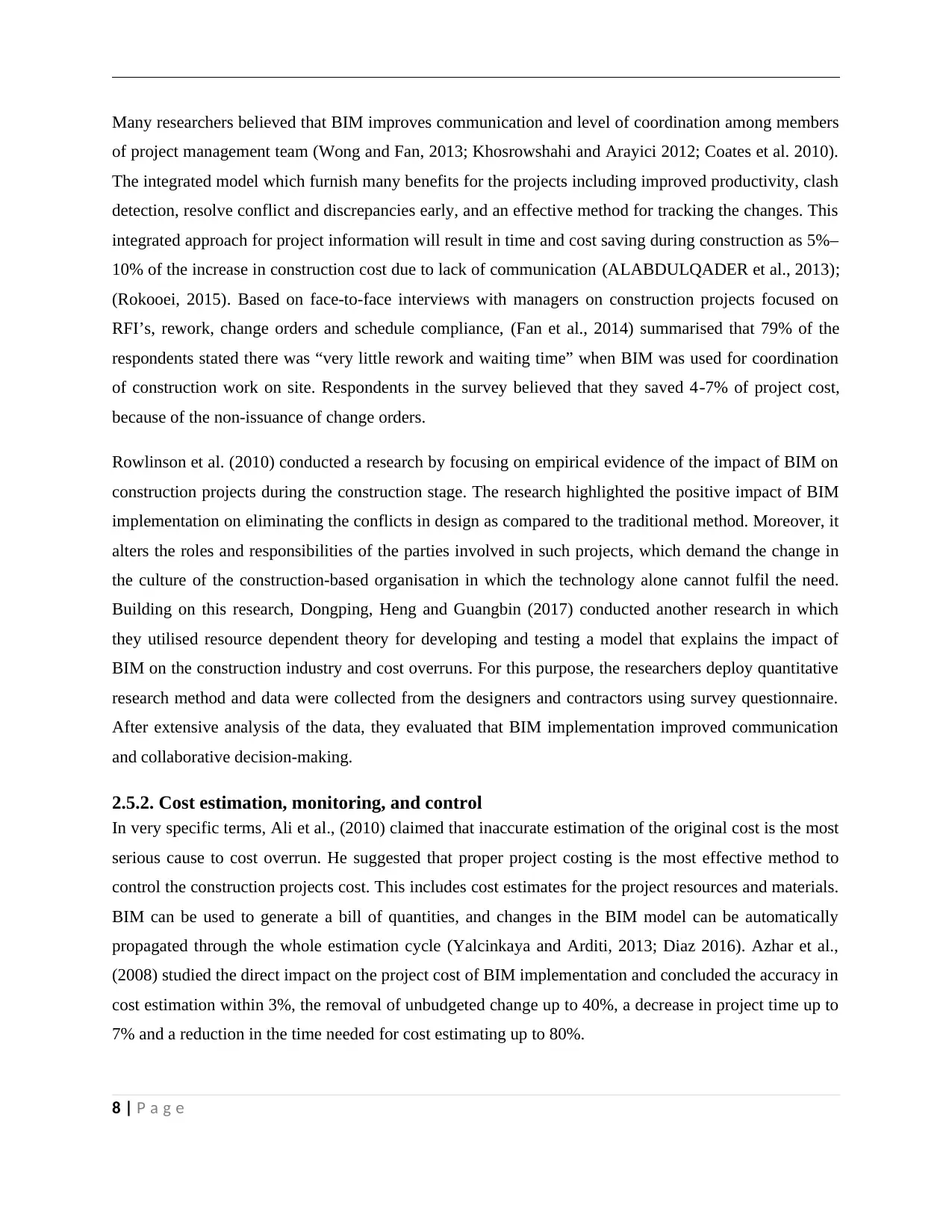
Many researchers believed that BIM improves communication and level of coordination among members
of project management team (Wong and Fan, 2013; Khosrowshahi and Arayici 2012; Coates et al. 2010).
The integrated model which furnish many benefits for the projects including improved productivity, clash
detection, resolve conflict and discrepancies early, and an effective method for tracking the changes. This
integrated approach for project information will result in time and cost saving during construction as 5%–
10% of the increase in construction cost due to lack of communication (ALABDULQADER et al., 2013);
(Rokooei, 2015). Based on face-to-face interviews with managers on construction projects focused on
RFI’s, rework, change orders and schedule compliance, (Fan et al., 2014) summarised that 79% of the
respondents stated there was “very little rework and waiting time” when BIM was used for coordination
of construction work on site. Respondents in the survey believed that they saved 4-7% of project cost,
because of the non-issuance of change orders.
Rowlinson et al. (2010) conducted a research by focusing on empirical evidence of the impact of BIM on
construction projects during the construction stage. The research highlighted the positive impact of BIM
implementation on eliminating the conflicts in design as compared to the traditional method. Moreover, it
alters the roles and responsibilities of the parties involved in such projects, which demand the change in
the culture of the construction-based organisation in which the technology alone cannot fulfil the need.
Building on this research, Dongping, Heng and Guangbin (2017) conducted another research in which
they utilised resource dependent theory for developing and testing a model that explains the impact of
BIM on the construction industry and cost overruns. For this purpose, the researchers deploy quantitative
research method and data were collected from the designers and contractors using survey questionnaire.
After extensive analysis of the data, they evaluated that BIM implementation improved communication
and collaborative decision-making.
2.5.2. Cost estimation, monitoring, and control
In very specific terms, Ali et al., (2010) claimed that inaccurate estimation of the original cost is the most
serious cause to cost overrun. He suggested that proper project costing is the most effective method to
control the construction projects cost. This includes cost estimates for the project resources and materials.
BIM can be used to generate a bill of quantities, and changes in the BIM model can be automatically
propagated through the whole estimation cycle (Yalcinkaya and Arditi, 2013; Diaz 2016). Azhar et al.,
(2008) studied the direct impact on the project cost of BIM implementation and concluded the accuracy in
cost estimation within 3%, the removal of unbudgeted change up to 40%, a decrease in project time up to
7% and a reduction in the time needed for cost estimating up to 80%.
8 | P a g e
of project management team (Wong and Fan, 2013; Khosrowshahi and Arayici 2012; Coates et al. 2010).
The integrated model which furnish many benefits for the projects including improved productivity, clash
detection, resolve conflict and discrepancies early, and an effective method for tracking the changes. This
integrated approach for project information will result in time and cost saving during construction as 5%–
10% of the increase in construction cost due to lack of communication (ALABDULQADER et al., 2013);
(Rokooei, 2015). Based on face-to-face interviews with managers on construction projects focused on
RFI’s, rework, change orders and schedule compliance, (Fan et al., 2014) summarised that 79% of the
respondents stated there was “very little rework and waiting time” when BIM was used for coordination
of construction work on site. Respondents in the survey believed that they saved 4-7% of project cost,
because of the non-issuance of change orders.
Rowlinson et al. (2010) conducted a research by focusing on empirical evidence of the impact of BIM on
construction projects during the construction stage. The research highlighted the positive impact of BIM
implementation on eliminating the conflicts in design as compared to the traditional method. Moreover, it
alters the roles and responsibilities of the parties involved in such projects, which demand the change in
the culture of the construction-based organisation in which the technology alone cannot fulfil the need.
Building on this research, Dongping, Heng and Guangbin (2017) conducted another research in which
they utilised resource dependent theory for developing and testing a model that explains the impact of
BIM on the construction industry and cost overruns. For this purpose, the researchers deploy quantitative
research method and data were collected from the designers and contractors using survey questionnaire.
After extensive analysis of the data, they evaluated that BIM implementation improved communication
and collaborative decision-making.
2.5.2. Cost estimation, monitoring, and control
In very specific terms, Ali et al., (2010) claimed that inaccurate estimation of the original cost is the most
serious cause to cost overrun. He suggested that proper project costing is the most effective method to
control the construction projects cost. This includes cost estimates for the project resources and materials.
BIM can be used to generate a bill of quantities, and changes in the BIM model can be automatically
propagated through the whole estimation cycle (Yalcinkaya and Arditi, 2013; Diaz 2016). Azhar et al.,
(2008) studied the direct impact on the project cost of BIM implementation and concluded the accuracy in
cost estimation within 3%, the removal of unbudgeted change up to 40%, a decrease in project time up to
7% and a reduction in the time needed for cost estimating up to 80%.
8 | P a g e
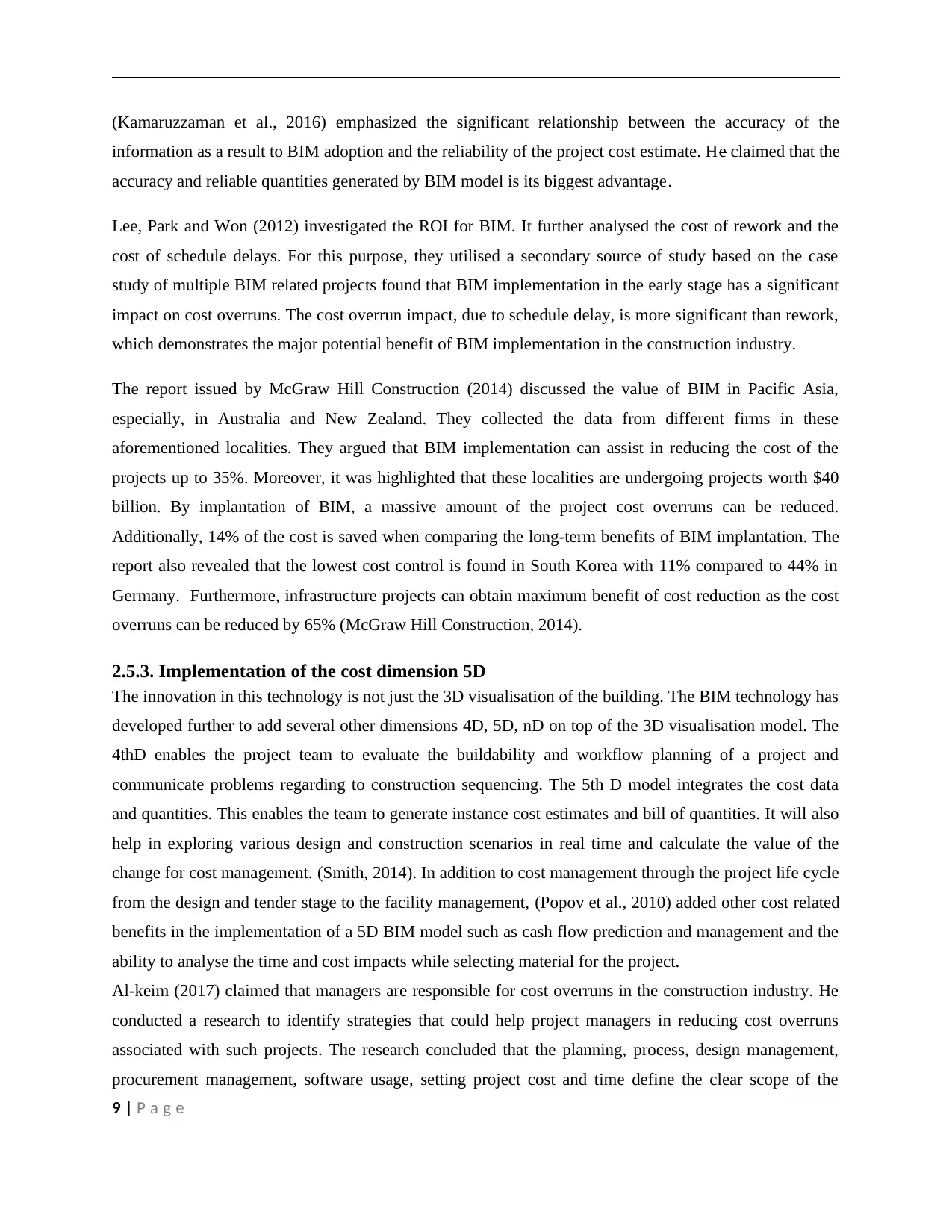
(Kamaruzzaman et al., 2016) emphasized the significant relationship between the accuracy of the
information as a result to BIM adoption and the reliability of the project cost estimate. He claimed that the
accuracy and reliable quantities generated by BIM model is its biggest advantage.
Lee, Park and Won (2012) investigated the ROI for BIM. It further analysed the cost of rework and the
cost of schedule delays. For this purpose, they utilised a secondary source of study based on the case
study of multiple BIM related projects found that BIM implementation in the early stage has a significant
impact on cost overruns. The cost overrun impact, due to schedule delay, is more significant than rework,
which demonstrates the major potential benefit of BIM implementation in the construction industry.
The report issued by McGraw Hill Construction (2014) discussed the value of BIM in Pacific Asia,
especially, in Australia and New Zealand. They collected the data from different firms in these
aforementioned localities. They argued that BIM implementation can assist in reducing the cost of the
projects up to 35%. Moreover, it was highlighted that these localities are undergoing projects worth $40
billion. By implantation of BIM, a massive amount of the project cost overruns can be reduced.
Additionally, 14% of the cost is saved when comparing the long-term benefits of BIM implantation. The
report also revealed that the lowest cost control is found in South Korea with 11% compared to 44% in
Germany. Furthermore, infrastructure projects can obtain maximum benefit of cost reduction as the cost
overruns can be reduced by 65% (McGraw Hill Construction, 2014).
2.5.3. Implementation of the cost dimension 5D
The innovation in this technology is not just the 3D visualisation of the building. The BIM technology has
developed further to add several other dimensions 4D, 5D, nD on top of the 3D visualisation model. The
4thD enables the project team to evaluate the buildability and workflow planning of a project and
communicate problems regarding to construction sequencing. The 5th D model integrates the cost data
and quantities. This enables the team to generate instance cost estimates and bill of quantities. It will also
help in exploring various design and construction scenarios in real time and calculate the value of the
change for cost management. (Smith, 2014). In addition to cost management through the project life cycle
from the design and tender stage to the facility management, (Popov et al., 2010) added other cost related
benefits in the implementation of a 5D BIM model such as cash flow prediction and management and the
ability to analyse the time and cost impacts while selecting material for the project.
Al-keim (2017) claimed that managers are responsible for cost overruns in the construction industry. He
conducted a research to identify strategies that could help project managers in reducing cost overruns
associated with such projects. The research concluded that the planning, process, design management,
procurement management, software usage, setting project cost and time define the clear scope of the
9 | P a g e
information as a result to BIM adoption and the reliability of the project cost estimate. He claimed that the
accuracy and reliable quantities generated by BIM model is its biggest advantage.
Lee, Park and Won (2012) investigated the ROI for BIM. It further analysed the cost of rework and the
cost of schedule delays. For this purpose, they utilised a secondary source of study based on the case
study of multiple BIM related projects found that BIM implementation in the early stage has a significant
impact on cost overruns. The cost overrun impact, due to schedule delay, is more significant than rework,
which demonstrates the major potential benefit of BIM implementation in the construction industry.
The report issued by McGraw Hill Construction (2014) discussed the value of BIM in Pacific Asia,
especially, in Australia and New Zealand. They collected the data from different firms in these
aforementioned localities. They argued that BIM implementation can assist in reducing the cost of the
projects up to 35%. Moreover, it was highlighted that these localities are undergoing projects worth $40
billion. By implantation of BIM, a massive amount of the project cost overruns can be reduced.
Additionally, 14% of the cost is saved when comparing the long-term benefits of BIM implantation. The
report also revealed that the lowest cost control is found in South Korea with 11% compared to 44% in
Germany. Furthermore, infrastructure projects can obtain maximum benefit of cost reduction as the cost
overruns can be reduced by 65% (McGraw Hill Construction, 2014).
2.5.3. Implementation of the cost dimension 5D
The innovation in this technology is not just the 3D visualisation of the building. The BIM technology has
developed further to add several other dimensions 4D, 5D, nD on top of the 3D visualisation model. The
4thD enables the project team to evaluate the buildability and workflow planning of a project and
communicate problems regarding to construction sequencing. The 5th D model integrates the cost data
and quantities. This enables the team to generate instance cost estimates and bill of quantities. It will also
help in exploring various design and construction scenarios in real time and calculate the value of the
change for cost management. (Smith, 2014). In addition to cost management through the project life cycle
from the design and tender stage to the facility management, (Popov et al., 2010) added other cost related
benefits in the implementation of a 5D BIM model such as cash flow prediction and management and the
ability to analyse the time and cost impacts while selecting material for the project.
Al-keim (2017) claimed that managers are responsible for cost overruns in the construction industry. He
conducted a research to identify strategies that could help project managers in reducing cost overruns
associated with such projects. The research concluded that the planning, process, design management,
procurement management, software usage, setting project cost and time define the clear scope of the
9 | P a g e
⊘ This is a preview!⊘
Do you want full access?
Subscribe today to unlock all pages.

Trusted by 1+ million students worldwide
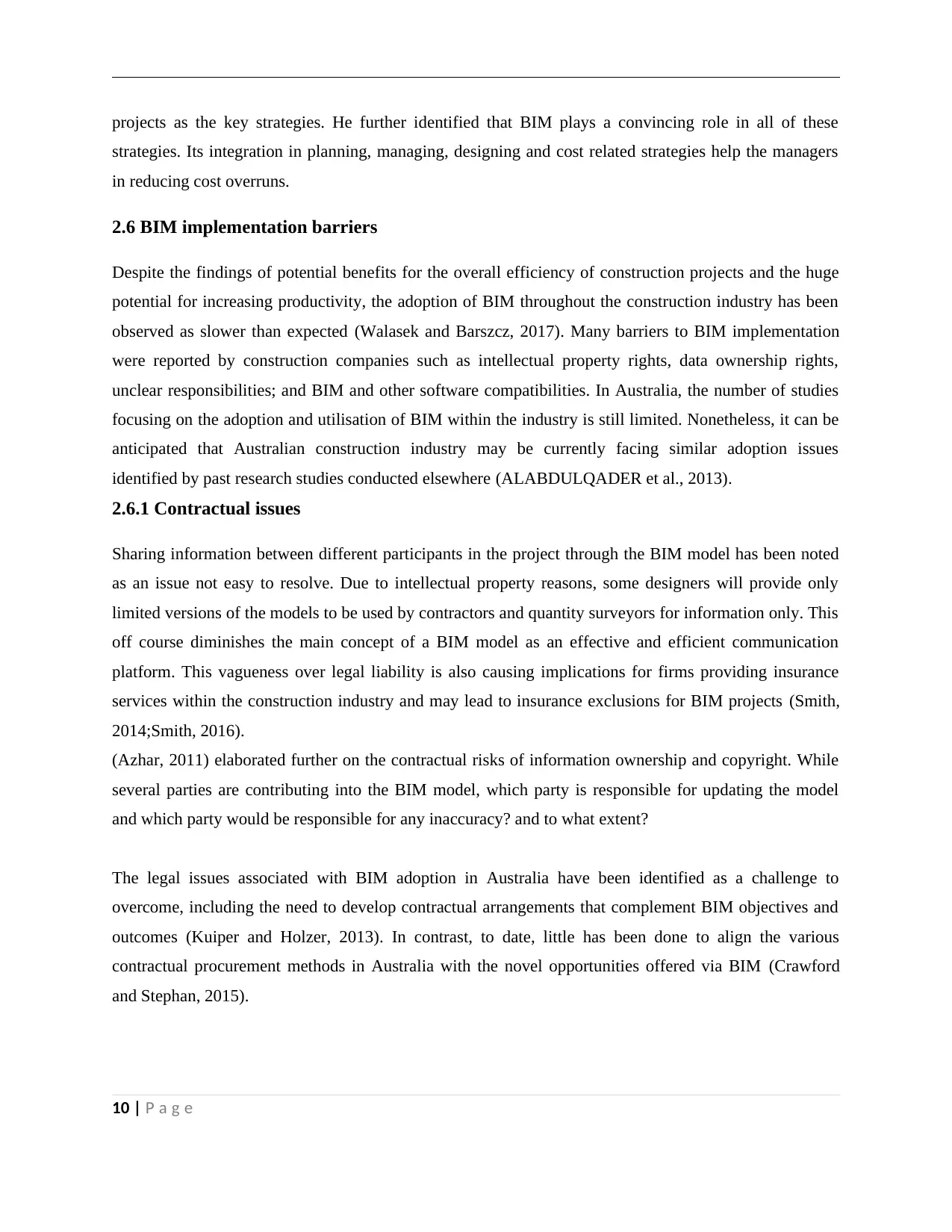
projects as the key strategies. He further identified that BIM plays a convincing role in all of these
strategies. Its integration in planning, managing, designing and cost related strategies help the managers
in reducing cost overruns.
2.6 BIM implementation barriers
Despite the findings of potential benefits for the overall efficiency of construction projects and the huge
potential for increasing productivity, the adoption of BIM throughout the construction industry has been
observed as slower than expected (Walasek and Barszcz, 2017). Many barriers to BIM implementation
were reported by construction companies such as intellectual property rights, data ownership rights,
unclear responsibilities; and BIM and other software compatibilities. In Australia, the number of studies
focusing on the adoption and utilisation of BIM within the industry is still limited. Nonetheless, it can be
anticipated that Australian construction industry may be currently facing similar adoption issues
identified by past research studies conducted elsewhere (ALABDULQADER et al., 2013).
2.6.1 Contractual issues
Sharing information between different participants in the project through the BIM model has been noted
as an issue not easy to resolve. Due to intellectual property reasons, some designers will provide only
limited versions of the models to be used by contractors and quantity surveyors for information only. This
off course diminishes the main concept of a BIM model as an effective and efficient communication
platform. This vagueness over legal liability is also causing implications for firms providing insurance
services within the construction industry and may lead to insurance exclusions for BIM projects (Smith,
2014;Smith, 2016).
(Azhar, 2011) elaborated further on the contractual risks of information ownership and copyright. While
several parties are contributing into the BIM model, which party is responsible for updating the model
and which party would be responsible for any inaccuracy? and to what extent?
The legal issues associated with BIM adoption in Australia have been identified as a challenge to
overcome, including the need to develop contractual arrangements that complement BIM objectives and
outcomes (Kuiper and Holzer, 2013). In contrast, to date, little has been done to align the various
contractual procurement methods in Australia with the novel opportunities offered via BIM (Crawford
and Stephan, 2015).
10 | P a g e
strategies. Its integration in planning, managing, designing and cost related strategies help the managers
in reducing cost overruns.
2.6 BIM implementation barriers
Despite the findings of potential benefits for the overall efficiency of construction projects and the huge
potential for increasing productivity, the adoption of BIM throughout the construction industry has been
observed as slower than expected (Walasek and Barszcz, 2017). Many barriers to BIM implementation
were reported by construction companies such as intellectual property rights, data ownership rights,
unclear responsibilities; and BIM and other software compatibilities. In Australia, the number of studies
focusing on the adoption and utilisation of BIM within the industry is still limited. Nonetheless, it can be
anticipated that Australian construction industry may be currently facing similar adoption issues
identified by past research studies conducted elsewhere (ALABDULQADER et al., 2013).
2.6.1 Contractual issues
Sharing information between different participants in the project through the BIM model has been noted
as an issue not easy to resolve. Due to intellectual property reasons, some designers will provide only
limited versions of the models to be used by contractors and quantity surveyors for information only. This
off course diminishes the main concept of a BIM model as an effective and efficient communication
platform. This vagueness over legal liability is also causing implications for firms providing insurance
services within the construction industry and may lead to insurance exclusions for BIM projects (Smith,
2014;Smith, 2016).
(Azhar, 2011) elaborated further on the contractual risks of information ownership and copyright. While
several parties are contributing into the BIM model, which party is responsible for updating the model
and which party would be responsible for any inaccuracy? and to what extent?
The legal issues associated with BIM adoption in Australia have been identified as a challenge to
overcome, including the need to develop contractual arrangements that complement BIM objectives and
outcomes (Kuiper and Holzer, 2013). In contrast, to date, little has been done to align the various
contractual procurement methods in Australia with the novel opportunities offered via BIM (Crawford
and Stephan, 2015).
10 | P a g e
Paraphrase This Document
Need a fresh take? Get an instant paraphrase of this document with our AI Paraphraser

2.6.2 Software training, incompatibility and data management
One of the main reasons for the BIM model to fall short from its potential is the incomplete data. (Smith,
2016) argued that, although there are many resons for having incomplete data in the model, the main
reason is either the cost of fully developing a comprehensive model or lack of experience of the team to
input the necessary information. Having many companies providing limited investement in digital
technology, in addition to the continual evolving technology, many in the construction industry are
questioning the outcome benifits after commiting considerable time and money on training and software
development. This, in turn, has a direct impact on the quality of the BIM model, as the model requires
input of vast amount of information and interconnected data.
Bryde et al., (2013) disagreed that the BIM cost is an issue. Hence the price for BIM software is similar to
CAD software. Even some vendors offer BIM and CAD packages for price of a CAD package alone.
However, he agreed that the upfront cost can still be substantial for small firms.
(ALABDULQADER et al., 2013) analysed the various reasons for which companies did not adopted BIM
technology as follows: 37.5% because the existing CAD system is sufficient. 32.2% Due to the cost of
BIM modling and 23.8% BIM was not required in the projects.
Software compatibility and Standardisation is another issue that causes barrier to its implantation and
optimal usage in construction industry. (Smith, 2014; Kenley et al., 2016). However, these issues are
being mitigated trough projects such as ThinkProject, A360 and ConjectPM (Walasek and Barszcz, 2017)
(Walasek and Barszcz, 2017).
In Australia and New Zealand, a survey has been conducted by A2K Technologies (2014). The results
highlighted the significance of BIM workability and inter-department collaboration issues within the
construction industry. The survey also confirmed that only 22% of firms having successfully incorporated
BIM into their design and construction operations (Ghaffarianhoseini et al., 2017).
2.6.3 Leadership driver
The countries governments are widely cited as the key leader for the construction industry transformation
(CIBER 2012, AIA 2010). Although the government’s request for BIM implementation in public projects
is growing, the lack of client demand remains one of the key obstacles to the propagation of BIM
(Crawford and Stephan, 2015).
11 | P a g e
One of the main reasons for the BIM model to fall short from its potential is the incomplete data. (Smith,
2016) argued that, although there are many resons for having incomplete data in the model, the main
reason is either the cost of fully developing a comprehensive model or lack of experience of the team to
input the necessary information. Having many companies providing limited investement in digital
technology, in addition to the continual evolving technology, many in the construction industry are
questioning the outcome benifits after commiting considerable time and money on training and software
development. This, in turn, has a direct impact on the quality of the BIM model, as the model requires
input of vast amount of information and interconnected data.
Bryde et al., (2013) disagreed that the BIM cost is an issue. Hence the price for BIM software is similar to
CAD software. Even some vendors offer BIM and CAD packages for price of a CAD package alone.
However, he agreed that the upfront cost can still be substantial for small firms.
(ALABDULQADER et al., 2013) analysed the various reasons for which companies did not adopted BIM
technology as follows: 37.5% because the existing CAD system is sufficient. 32.2% Due to the cost of
BIM modling and 23.8% BIM was not required in the projects.
Software compatibility and Standardisation is another issue that causes barrier to its implantation and
optimal usage in construction industry. (Smith, 2014; Kenley et al., 2016). However, these issues are
being mitigated trough projects such as ThinkProject, A360 and ConjectPM (Walasek and Barszcz, 2017)
(Walasek and Barszcz, 2017).
In Australia and New Zealand, a survey has been conducted by A2K Technologies (2014). The results
highlighted the significance of BIM workability and inter-department collaboration issues within the
construction industry. The survey also confirmed that only 22% of firms having successfully incorporated
BIM into their design and construction operations (Ghaffarianhoseini et al., 2017).
2.6.3 Leadership driver
The countries governments are widely cited as the key leader for the construction industry transformation
(CIBER 2012, AIA 2010). Although the government’s request for BIM implementation in public projects
is growing, the lack of client demand remains one of the key obstacles to the propagation of BIM
(Crawford and Stephan, 2015).
11 | P a g e
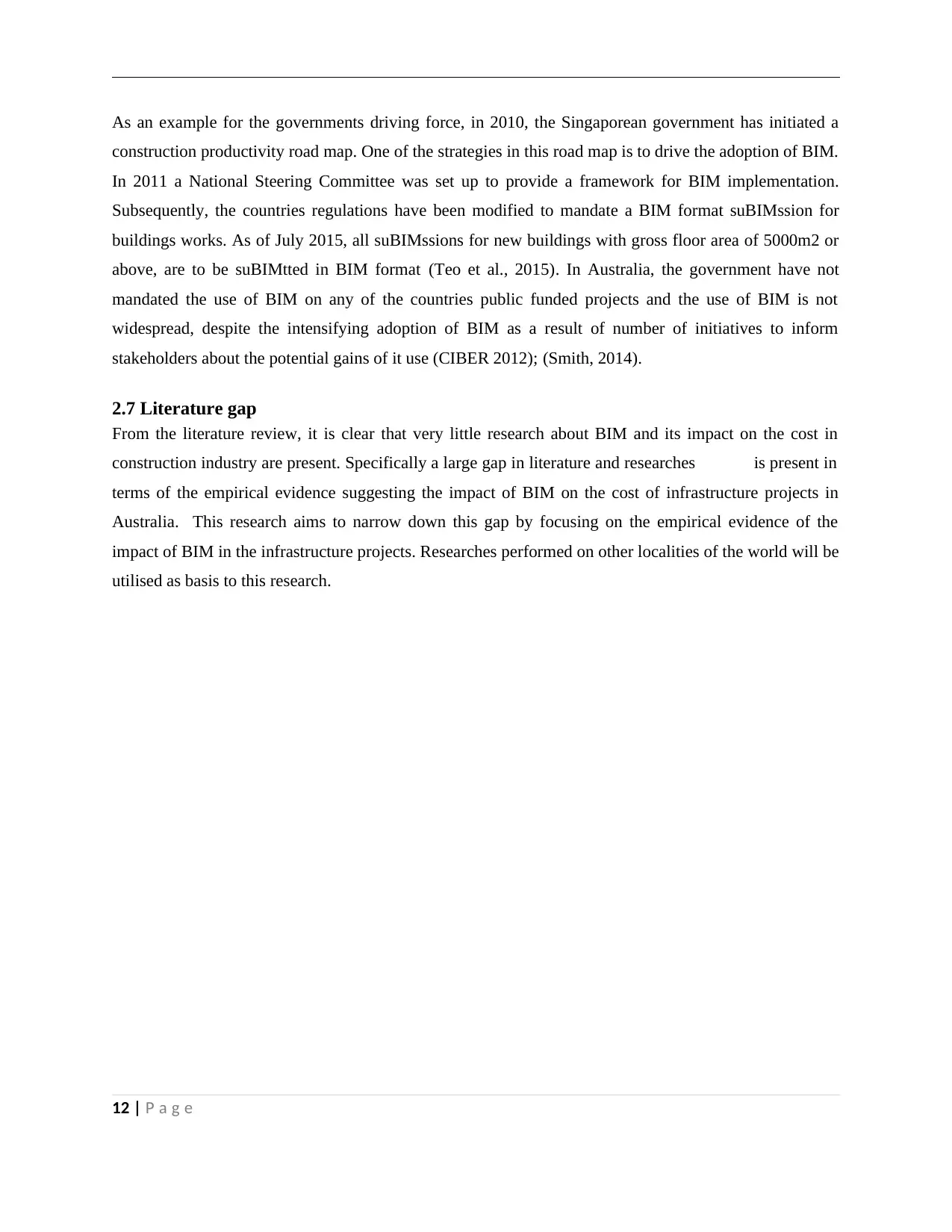
As an example for the governments driving force, in 2010, the Singaporean government has initiated a
construction productivity road map. One of the strategies in this road map is to drive the adoption of BIM.
In 2011 a National Steering Committee was set up to provide a framework for BIM implementation.
Subsequently, the countries regulations have been modified to mandate a BIM format suBIMssion for
buildings works. As of July 2015, all suBIMssions for new buildings with gross floor area of 5000m2 or
above, are to be suBIMtted in BIM format (Teo et al., 2015). In Australia, the government have not
mandated the use of BIM on any of the countries public funded projects and the use of BIM is not
widespread, despite the intensifying adoption of BIM as a result of number of initiatives to inform
stakeholders about the potential gains of it use (CIBER 2012); (Smith, 2014).
2.7 Literature gap
From the literature review, it is clear that very little research about BIM and its impact on the cost in
construction industry are present. Specifically a large gap in literature and researches is present in
terms of the empirical evidence suggesting the impact of BIM on the cost of infrastructure projects in
Australia. This research aims to narrow down this gap by focusing on the empirical evidence of the
impact of BIM in the infrastructure projects. Researches performed on other localities of the world will be
utilised as basis to this research.
12 | P a g e
construction productivity road map. One of the strategies in this road map is to drive the adoption of BIM.
In 2011 a National Steering Committee was set up to provide a framework for BIM implementation.
Subsequently, the countries regulations have been modified to mandate a BIM format suBIMssion for
buildings works. As of July 2015, all suBIMssions for new buildings with gross floor area of 5000m2 or
above, are to be suBIMtted in BIM format (Teo et al., 2015). In Australia, the government have not
mandated the use of BIM on any of the countries public funded projects and the use of BIM is not
widespread, despite the intensifying adoption of BIM as a result of number of initiatives to inform
stakeholders about the potential gains of it use (CIBER 2012); (Smith, 2014).
2.7 Literature gap
From the literature review, it is clear that very little research about BIM and its impact on the cost in
construction industry are present. Specifically a large gap in literature and researches is present in
terms of the empirical evidence suggesting the impact of BIM on the cost of infrastructure projects in
Australia. This research aims to narrow down this gap by focusing on the empirical evidence of the
impact of BIM in the infrastructure projects. Researches performed on other localities of the world will be
utilised as basis to this research.
12 | P a g e
⊘ This is a preview!⊘
Do you want full access?
Subscribe today to unlock all pages.

Trusted by 1+ million students worldwide
1 out of 38
Related Documents
Your All-in-One AI-Powered Toolkit for Academic Success.
+13062052269
info@desklib.com
Available 24*7 on WhatsApp / Email
![[object Object]](/_next/static/media/star-bottom.7253800d.svg)
Unlock your academic potential
Copyright © 2020–2025 A2Z Services. All Rights Reserved. Developed and managed by ZUCOL.





